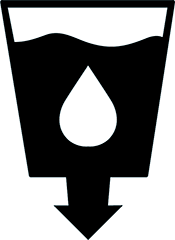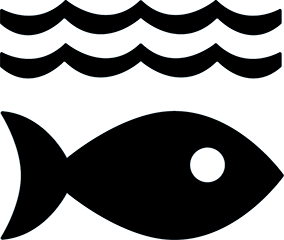UN Sustainable Development Goals Addressed
-

Goal 6: Clean Water & Sanitation
-

Goal 8: Decent Work and Economic Growth
-

Goal 12: Responsible Production & Consumption
-

Goal 14: Life Below Water
2020 Global Design Challenge Finalist
This design concept was developed by participants in the Institute’s Global Design Challenge. The descriptions below are from the team’s competition entry materials.
Location: Adelaide, Australia
Team members: Luke Heffernan, Han Huang, Sanchita Anand, Martin Gallo Picon, Matthew King, Sophie Heath
Innovation Details
Agricultural runoff is a major source of excess nutrients in waterways that can lead to harmful algal blooms and oxygen depletion. nutriBarrier is designed to be deployed around crops to reduce this runoff while also ensuring a slow release of fertilizer. Made from materials inspired by the protective strategies of hagfish and frogs, this barrier can be woven around individual plants in a pattern, using materials economically while protecting and watering each plant.
What is the problem you are trying to solve and how is it related to the united nations sustainable development goals?
Blue-green algae blooms are a global issue that affects waterways of all sizes, with detrimental effects on aquatic ecosystems, terrestrial wildlife, and human settlement alike. As the algae – more formally known as – grows and consumes oxygen through respiration, oxygen levels in the water drop to dangerous levels. Once conditions become unsuitable for algae growth, the dead algae becomes a food source for bacteria that depletes oxygen from both the water and the air, creating dead zones where no flora or fauna can survive. Furthermore, algae cells can leak toxins that persist for months, poisoning surrounding life, directly impacting humans through their consumption of contaminated seafood. By addressing the problem through the nutriBarrier, we are ensuring the sustainable management of water, and conservation of marine and surrounding ecosystems through a significant reduction in marine pollution. The nutriBarrier also encourages and supports sustainable agricultural practices, as agricultural fertiliser run-off is a prominent contributor to eutrophication.
The original SDG we were intending to focus on was “(6) Clean Water and Sanitation”. However, we recognised from the start that, by understanding the broader perspective of the problem through a careful systems engineering approach, along with gaining some sound economic and business advice, we could aim higher than a single goal without compromising our original plans. We chose to tackle a large-scale problem that limits access to both potable and irrigative water, nutritious food, and sustainable employment, and increasingly more so as our global climate changes. By addressing one of its root causes, we may potentially make available thousands of gigalitres of clean water, and set the stage for a boom in agricultural efficiency worldwide. In doing so, we argue we will be addressing SDGs 6, 2, 14, 15, 1, 13, 12, 3, and 8 (in descending order of relevance).
What organisms/natural systems did you learn from and how did what you learned inform your design?
By framing the problem of growing and fertilising crops as a process of nurturing, we recognised that it is closely related to many organisms’ defence mechanisms. Defence mechanisms present themselves in many forms: active or passive; strength or speed; innate or resourced, and more. We learned from frogs, which beat their legs while mating to create a mound of protective bubbles over their nests. This shield guards each individual future tadpole from the ravages of the weather and the river they have been laid in. A symbiotic relationship was discovered between squirrels and oak trees, where acorns stored by the squirrels over time release and germinate into oak tree seedlings. This was the inspiration for storing fertiliser inside a protective porous membrane so that it gradually (rather than instantaneously) releases to plants. We were educated by the myxini hagfish, which releases a rapidly expanding gel from its skin when threatened, forming a barrier from predators and confusing them. As it can only produce a small amount of gel with the limited resources at the depths it lives, its ultra absorptive capability is essential for survival. To optimise material usage and the amount of the nutriBarrier applied to crops, we looked to the DNA double helix, which optimises information storage in space due to its unique shape. Each of these natural systems provided creative guidance to our team, but in tandem, many of them produced even more valuable lessons. Guided by the frogs and DNA, we can weave threads of the barrier around individual plants in a helix pattern, using materials more economically while protecting and watering each plant. The myxini gel and frogs together inspired us to capture local resources to provide protection as needed, which was applied not just to the fertiliser, but also the plants.
What does your design solution do? How does it address the problem or opportunity you selected?
Rather than tackle the problem once it has already started, the nutriBarrier aims to cut off eutrophication at its source, as advised by experts. This not only works to solve the problem of algae growth, but also increases the efficiency of water and fertiliser. As both of these are becoming ever more scarce in this changing global climate, experts suggest this could revolutionise the agricultural industry. From an agricultural perspective, excessive application of fertiliser has few direct disadvantages. Many farmers will simply distribute their fertilisers through irrigation or hoppers, applying more as it is washed away by rain and storms. However, using mulch to retain this water and fertiliser is standard practice, and leveraging that was targeted as a key to success. By augmenting various types of mulch with fertiliser shrouded in extremely water absorbent compounds, crucial resources are retained better than ever, and released sustainably across a longer period of time. As an additional effect, the absorptive growth of these compounds also provides mechanical slowing of flow across farms, further restricting run-off. This approach applies modern materials science to the broad and often harsh conditions found across agricultural regions worldwide, increasing water and fertiliser efficiency. This is obviously not the first attempt made to tackle this issue, so the question we regularly asked of our experts was “what is the biggest roadblock to adoption of proposed solutions?” Outside the realm of legislation, it was suggested the biggest impediment was the costs that some environmental initiatives impose on agriculturalists. By favouring familiar, affordable, low-tech, and locally sourced components, we strongly considered the ecosystem the nutriBarrier will be used in, and expect that it should not just be usable, but the first choice for many farmers for fertilising and irrigating their crops.



